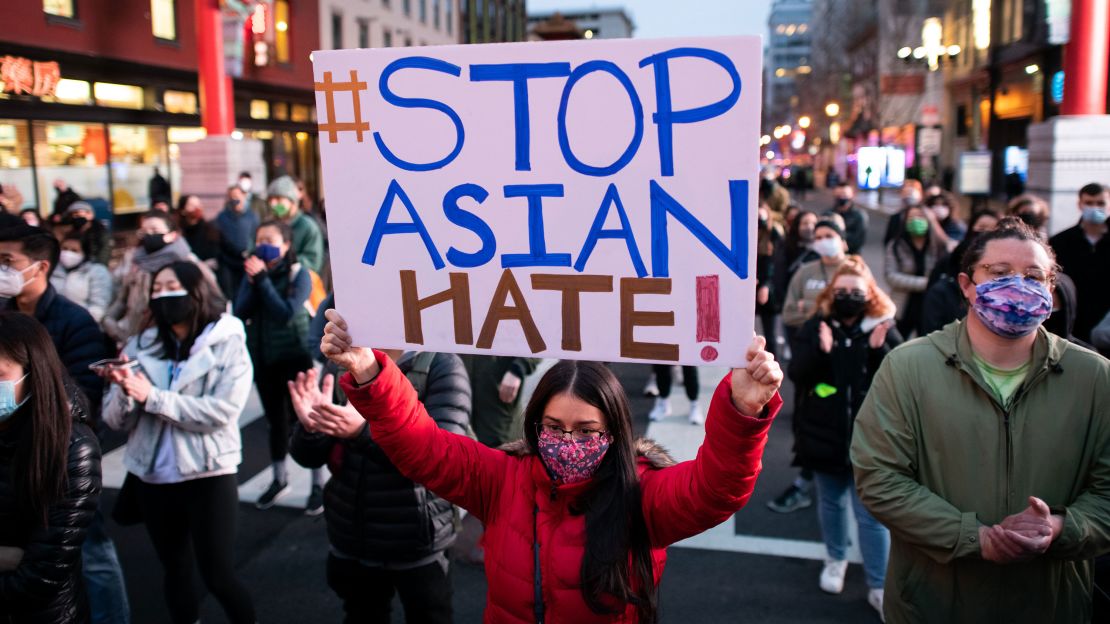Editor’s Note: The Rev. Laura Mariko Cheifetz is assistant dean of admissions, vocation and stewardship at Vanderbilt Divinity School. She is an ordained minister in the Presbyterian Church (USA).
“You’re a cute little tricksy.”
That’s what a White male customer at the Poulsbo, Washington, bookstore where my mother and I worked called my mother 28 years ago, when I was just 15.
Our co-worker overheard him and was angry, but my mother was just annoyed. She was simply trying to sell books.

That was the day I began to understand more about what it means to be an Asian American woman in the United States. By college, I knew more about sexualized violence by US military personnel toward women in Asia, and how centuries of racist stereotypes about Asian and Asian American women could be experienced concretely.
A temptation to ‘eliminate’
In the March 16 Atlanta shootings, complex human identities – real lives and stories – were reduced to objects. Before we knew the names, ages, ethnicities, family backgrounds or migration stories of the six women of Asian descent murdered in three spas spanning the Atlanta metro area, we knew that the man charged with shooting them was a churchgoing White man seeing the spas as a “temptation” that he “wanted to eliminate.”

This is textbook sexism, racism, objectification and misogynistic violence.
Asian and Asian American women are objects of temptation. In the alleged shooter’s Christian worldview, we are the cause of his sin. His vision fit into an ardently evangelical tradition such as the Southern Baptist Convention, a denomination whose roots are White supremacist, where we are targets for missionary activity, or a jumbled set of stereotypes to be mined for mediocre racist curriculum.
We are not fully human, with loves, religious beliefs, fears, families, shortcomings, hopes.
We are objects
In the early 1900s, Filipinos were put on display like animals at the St. Louis World’s Fair. “Ch*nk,” “J*p” and “g**k” are slurs hurled at us. During World War II, with persecution of Japanese and Japanese Americans, other Asian Americans would wear buttons declaring “I’m Chinese” or “I’m Korean.” Most of us who are not Chinese react, upon being called “ch*nk,” with “I’m not Chinese.” Vincent Chin, a Chinese American man, was killed by White unemployed auto workers who were angry at Japanese car companies.
We are simply objects. Our ethnic identities matter to us, but not to American White supremacy. We who are Asian or Asian American women have our own lives and agency, but to American White supremacy, we are hypersexualized dragon ladies and young brides to be sold. And to the shooter, objects tempting him to sin. Objects to be eliminated.
These women were likely the most vulnerable among us – yes, among the so-called model minority. That myth is deadly, erasing the lives that many of us live on the margins, in precarious financial, immigration and vocational situations.
A huge gash in our social fabric
These murdered women leave behind not emptiness, or an absence of temptation. They leave behind families shredded with grief. They leave communities who depended upon them. They leave children who will never be held by their mother again, parents who will never see their daughters, vacant holes in the hearts of an entire network of people who are nothing but faceless Asian hordes to White American supremacy.
I told an Asian American friend to quit her habit of running outside for exercise. Another friend, Clara Seo, said she feels like “someone melon-scooped my heart. Someone took a little melon baller and took a tiny round scoop out.” Have you ever scooped out a melon? At the end, there is mostly a shell with melon-shaped wounds in it.
White supremacy rips a huge gash into the melon that is our social fabric, and now it is scooping away at us. The 2018 shooting at the Tree of Life synagogue in Pittsburgh. The faithful at Mother Emmanuel cut down after Bible study in 2015. The 2012 shooting at the gurdwara in Oak Creek, Wisconsin. The Asian and Pacific Islander elders who have been beaten, shoved, stabbed and murdered over the past year. Missing and murdered Indigenous women. The migrant children, most of them Mexican and Central American, separated from their families and imprisoned along the border, or disappeared into a foster care system with shoddy tracking. Ahmaud Arbery, Sandra Bland, Tamir Rice and George Floyd.
This is who we are
The tale of racist and White supremacist violence in the United States has a narrative arc in the popular imagination. It begins with a violent act, catching dominant culture by surprise. This shock is treated as an exception. It was a bad day, after all, for the perpetrator, and he was at the end of his rope. It is declared that this one-off incident is a bad apple problem. It is “not who we are.” And eventually, it is forgotten.
But this is exactly who we are as a country. And say something about how we are still grappling with the project that was the Civil War and slavery? Let’s not forget the significance of January 6, when one of the insurgents entered the halls of the US Capitol carrying the Confederate flag.
There is another narrative arc. For those of us who live and love in this country, and are told we are never fully American, the violent act feels familiar. We feel rage and fear. We worry about the family members left behind, the people behind the businesses impacted. We know this is who this country is, and who we are to it: the perpetual foreigner.
And we will not be able to heal until we begin to acknowledge American civilization is made up of shredded pieces of the lives of vulnerable people.





